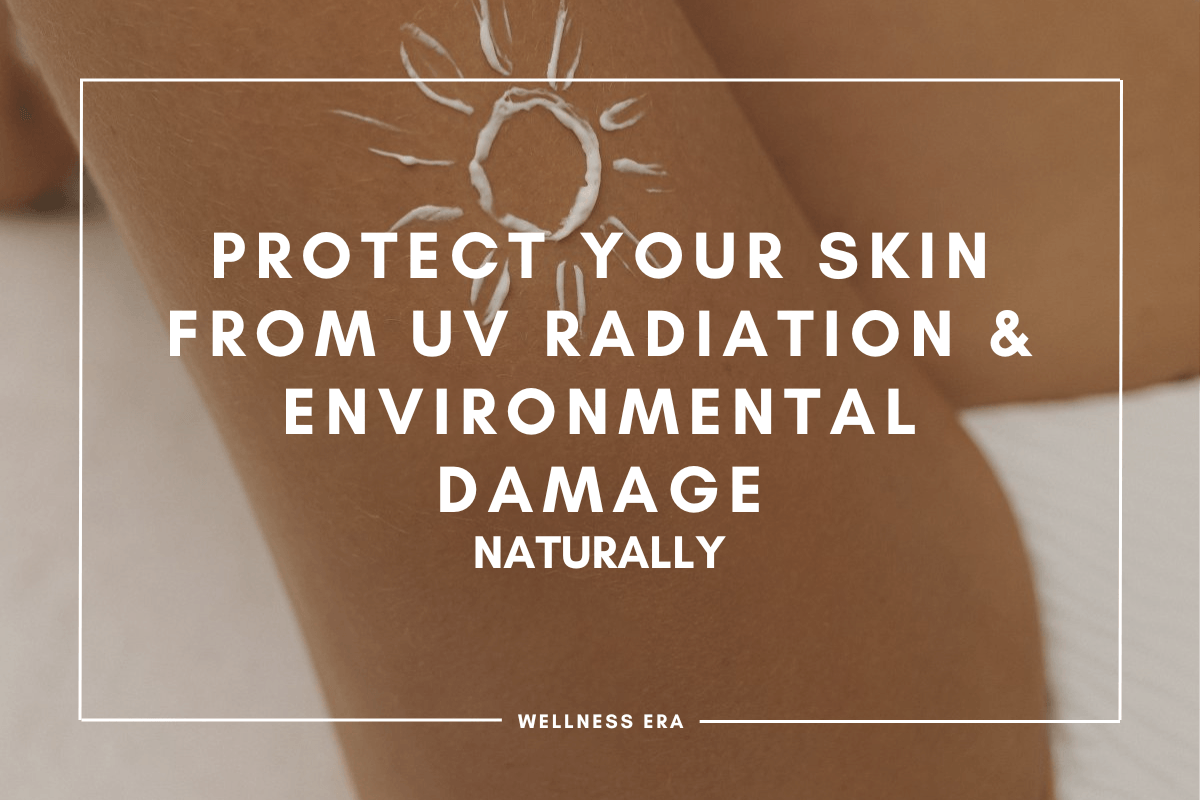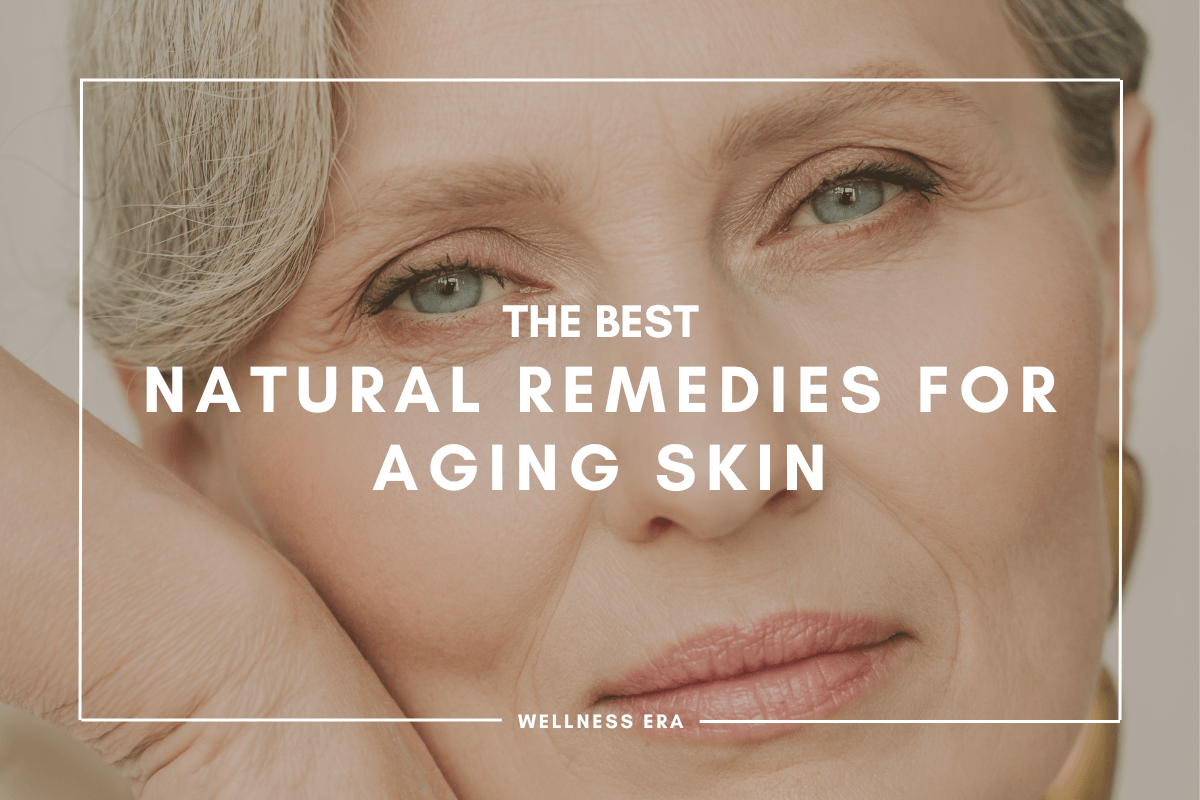Defend Your Skin: Fighting Free Radicals with Antioxidants
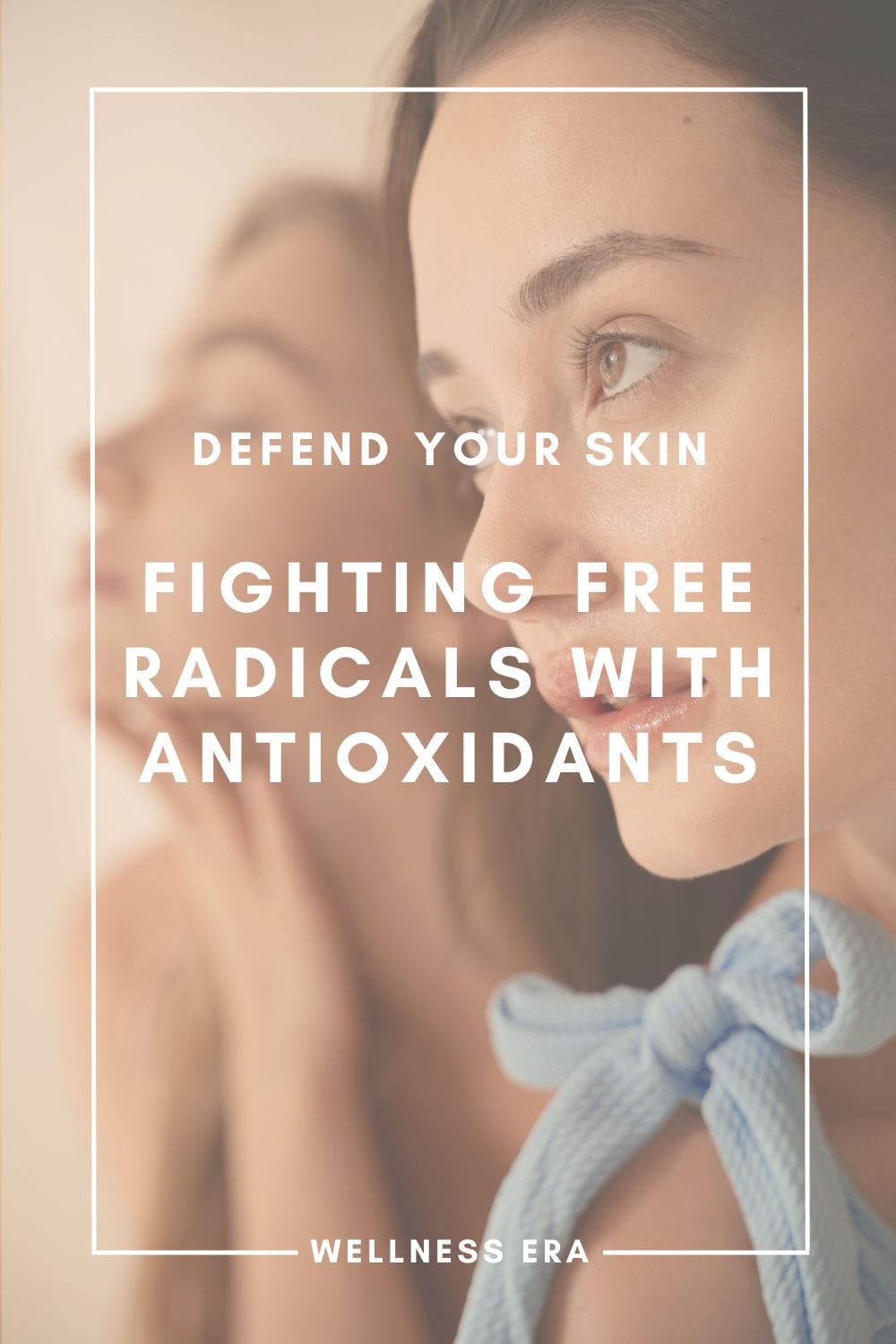
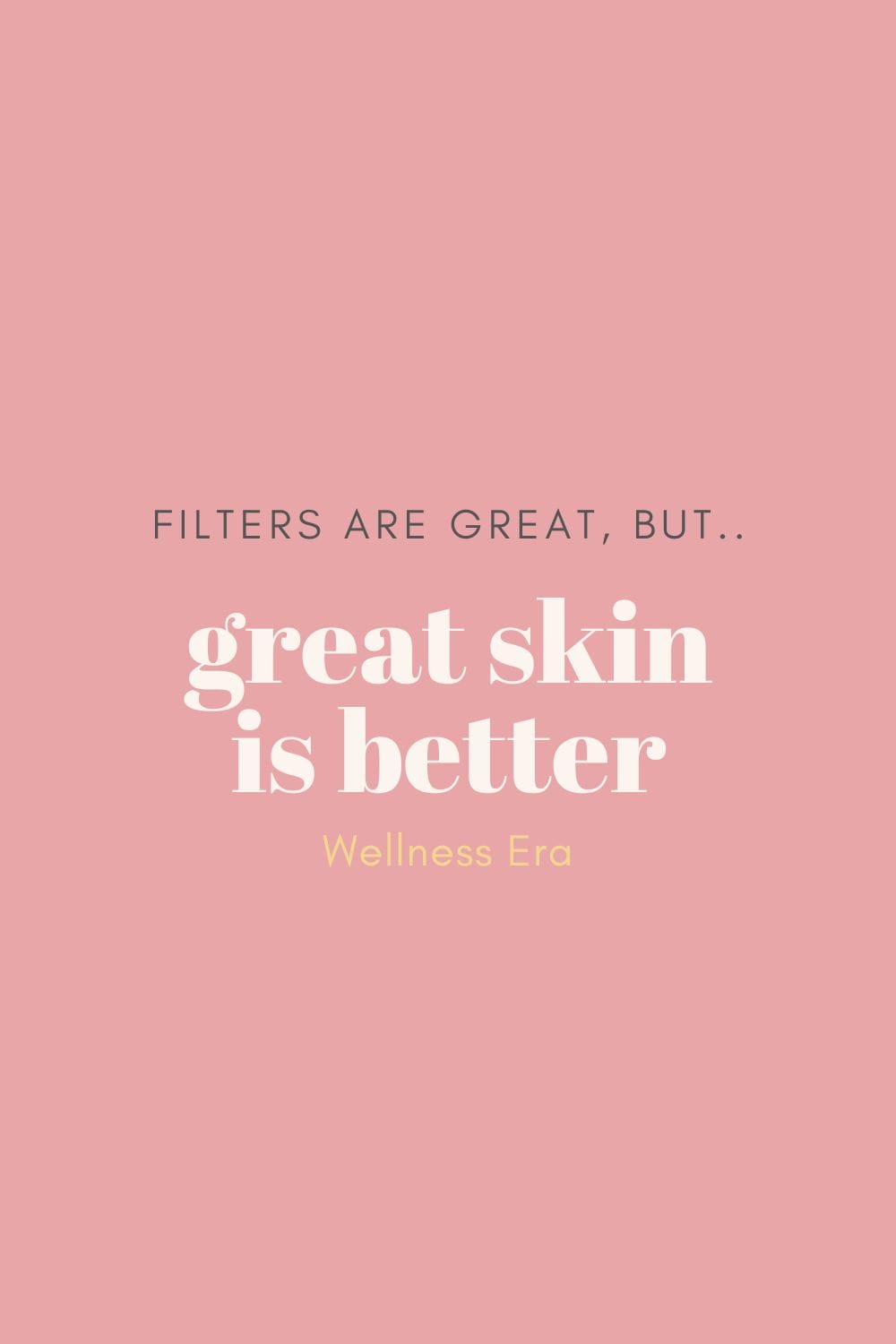
Free radicals are stealthy enemies of youthful skin, accelerating the aging process by damaging collagen and elastin. These unstable molecules wreak havoc by triggering oxidative stress, leading to wrinkles, sagging, and dullness. Luckily, nature has armed us with powerful defenders: antioxidants. These compounds neutralize free radicals, preventing damage and preserving your skin’s natural glow.
How Free Radicals Cause Skin Damage
Free radicals arise naturally in your body but are also triggered by external factors like UV radiation, pollution, and smoking. These harmful molecules have an unpaired electron, making them hyper-reactive. Once they interact with healthy skin cells, they initiate a chain reaction known as oxidative stress, breaking down collagen, elastin, and lipids (Halliwell and Gutteridge, 2015).
This process accelerates signs of aging, such as fine lines, wrinkles, and a weakened skin barrier. Oxidative stress can leave your skin more prone to dehydration, irritation, and age spots (Poljšak & Dahmane, 2012).
The Science Behind Free Radicals and Oxidative Stress
Reactive Oxygen Species (ROS): Free radicals, or ROS, are byproducts of cellular metabolism. While ROS plays a role in cellular processes, an overabundance leads to oxidative stress (Sies et al., 2017).
Impact on Skin Proteins: Collagen and elastin—the scaffolding of your skin—are particularly vulnerable to free radical damage. As they break down, skin loses firmness and elasticity (Valko et al., 2007).
Consequences for Skin Health: Prolonged oxidative stress not only leads to visible aging but also weakens the skin’s protective barrier, making it susceptible to environmental damage and inflammation (Poljšak & Dahmane, 2012).
Since UV radiation is one of the biggest triggers of free radical damage, protecting your skin from sun exposure is essential.Discover natural ways to shield your skin from UV rays and environmental stressors.
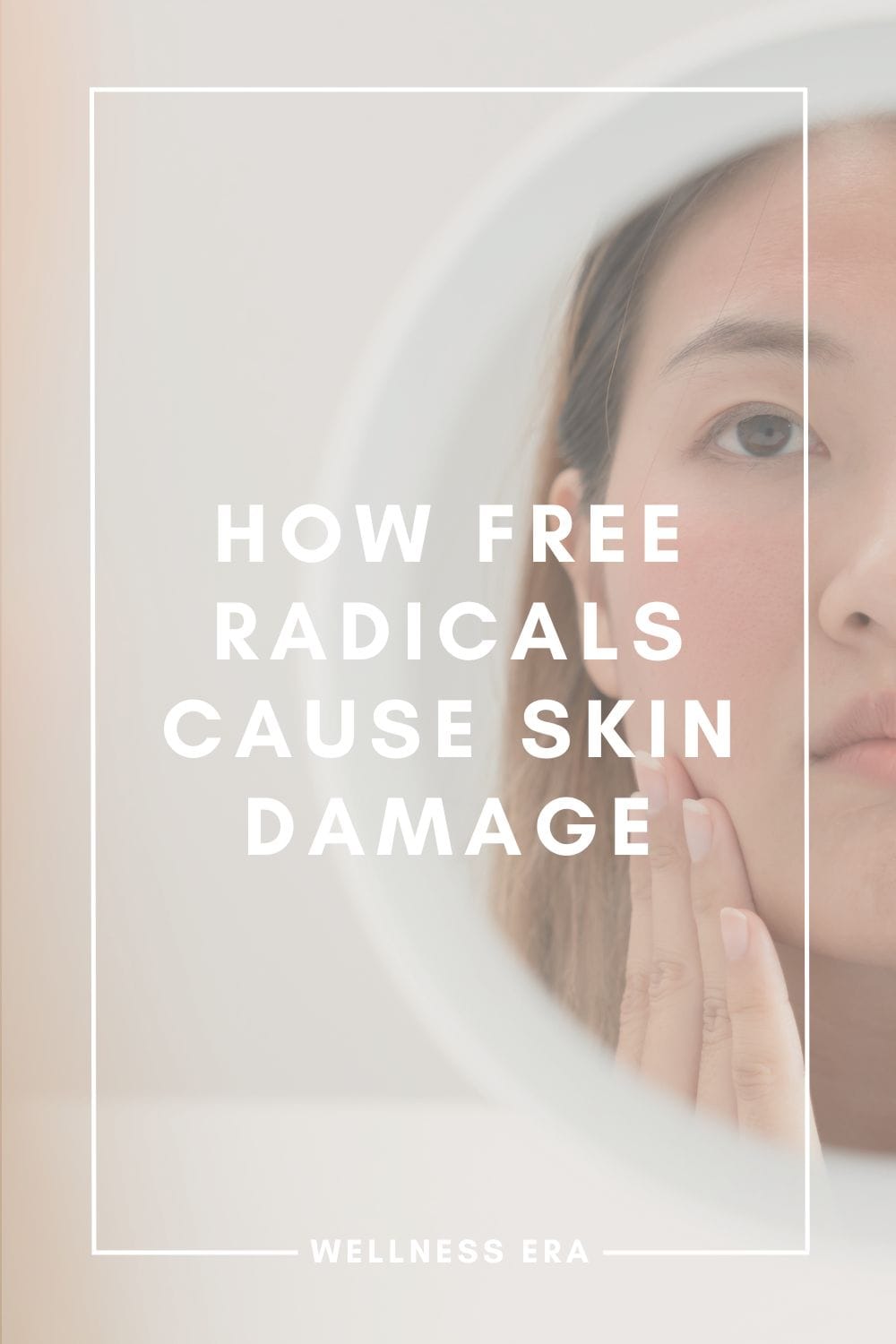
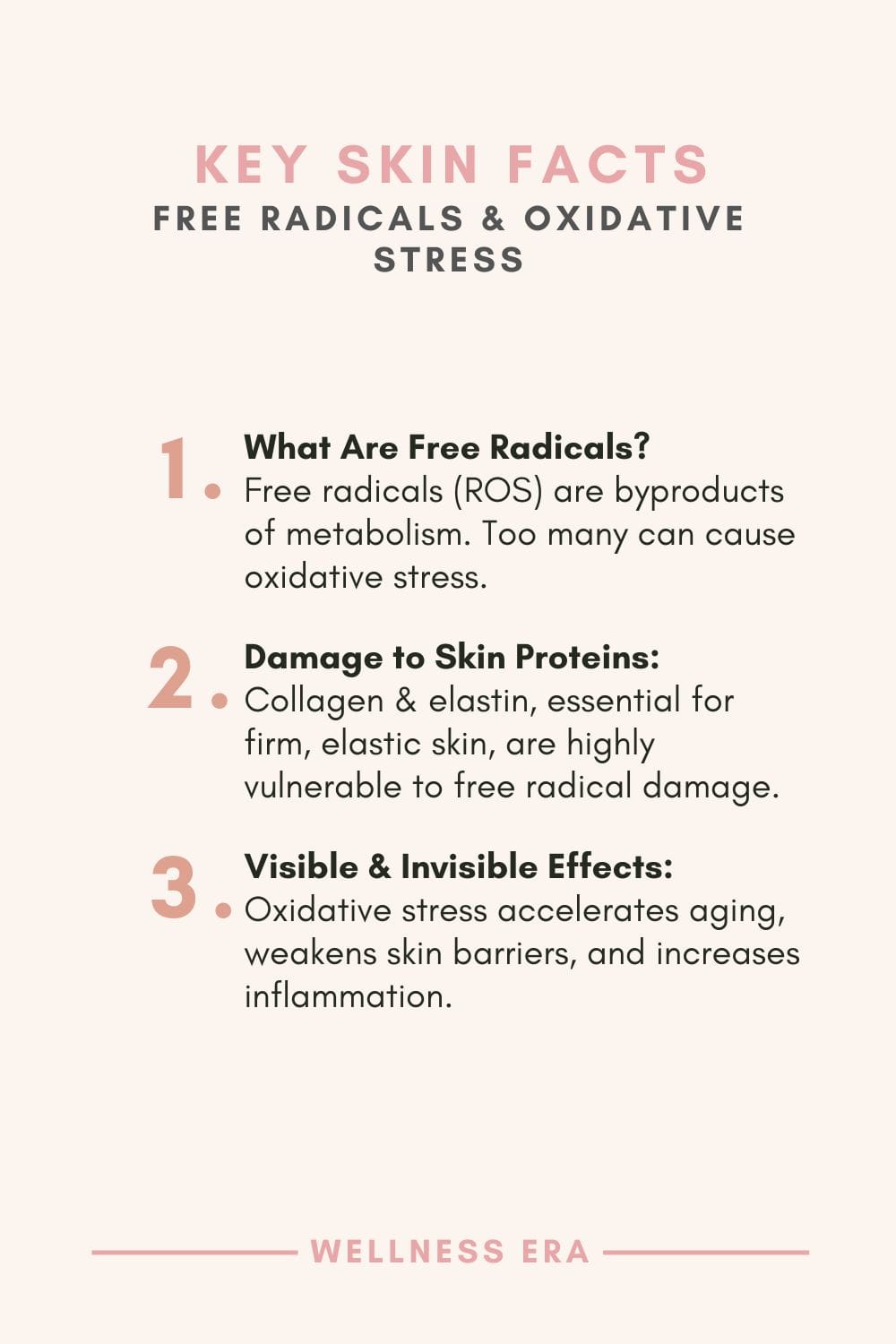
References
Halliwell, B. and Gutteridge, J.M.C. (2015). Free Radicals in Biology and Medicine. 5th edn. Oxford: Oxford University Press.
Poljšak, B., & Dahmane, R. (2012). Free radicals and extrinsic skin aging. Dermatology Research and Practice, 2012, Article ID 135206. NCBI
Sies, H. (2017). Oxidative stress: A concept in redox biology and medicine. Redox Biology, 4(11), 180-183. PubMed
Valko, M., Leibfritz, D., Moncol, J., et al. (2007). Free radicals and antioxidants in normal physiological functions and human disease. International Journal of Biochemistry & Cell Biology, 39(1), 44-84. ScienceDirect
How to Incorporate Antioxidants into Your Routine
Antioxidants are nature’s antidote to free radicals. They work by neutralizing these unstable molecules, stopping damage before it occurs. By including antioxidant-rich foods in your diet and applying antioxidant-packed skincare products, you can protect your skin both inside and out.
Incorporate Antioxidants In Your Diet:
A nutrient-rich diet is essential for maintaining skin health. Foods high in antioxidants help fight oxidative stress and promote overall wellness.
Antioxidant whole foods:
Fruits: Blueberries, cherries, pomegranates, cranberries, oranges.
Vegetables: Broccoli, kale, spinach, artichokes, beets.
Nuts and Seeds: Pecans, walnuts, almonds, chia seeds, flaxseeds.
Beverages: Green tea, coffee, red wine, herbal teas.
Spices and Herbs: Turmeric, cinnamon, oregano, cloves, ginger.
These foods have antioxidant effects by eating them, because they are compounds that neutralize free radicals, reducing oxidative stress and preventing damage to cells. These antioxidants can also be are categorized into different types based on their chemical structure and function.
Want to deepen your understanding of how nutrition impacts skin health?Explore the science behind whole food nutrition and how it supports a naturally radiant complexion.
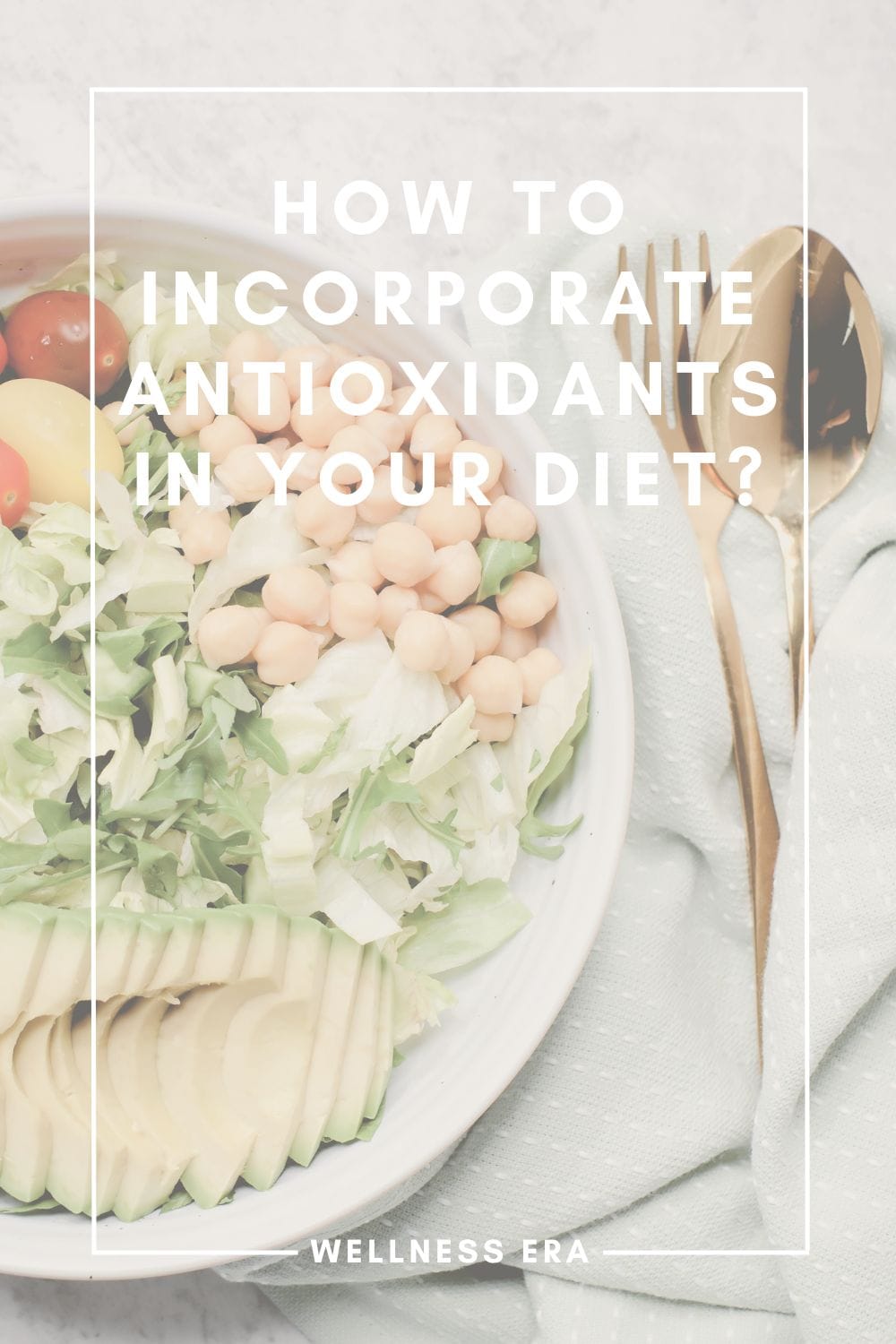
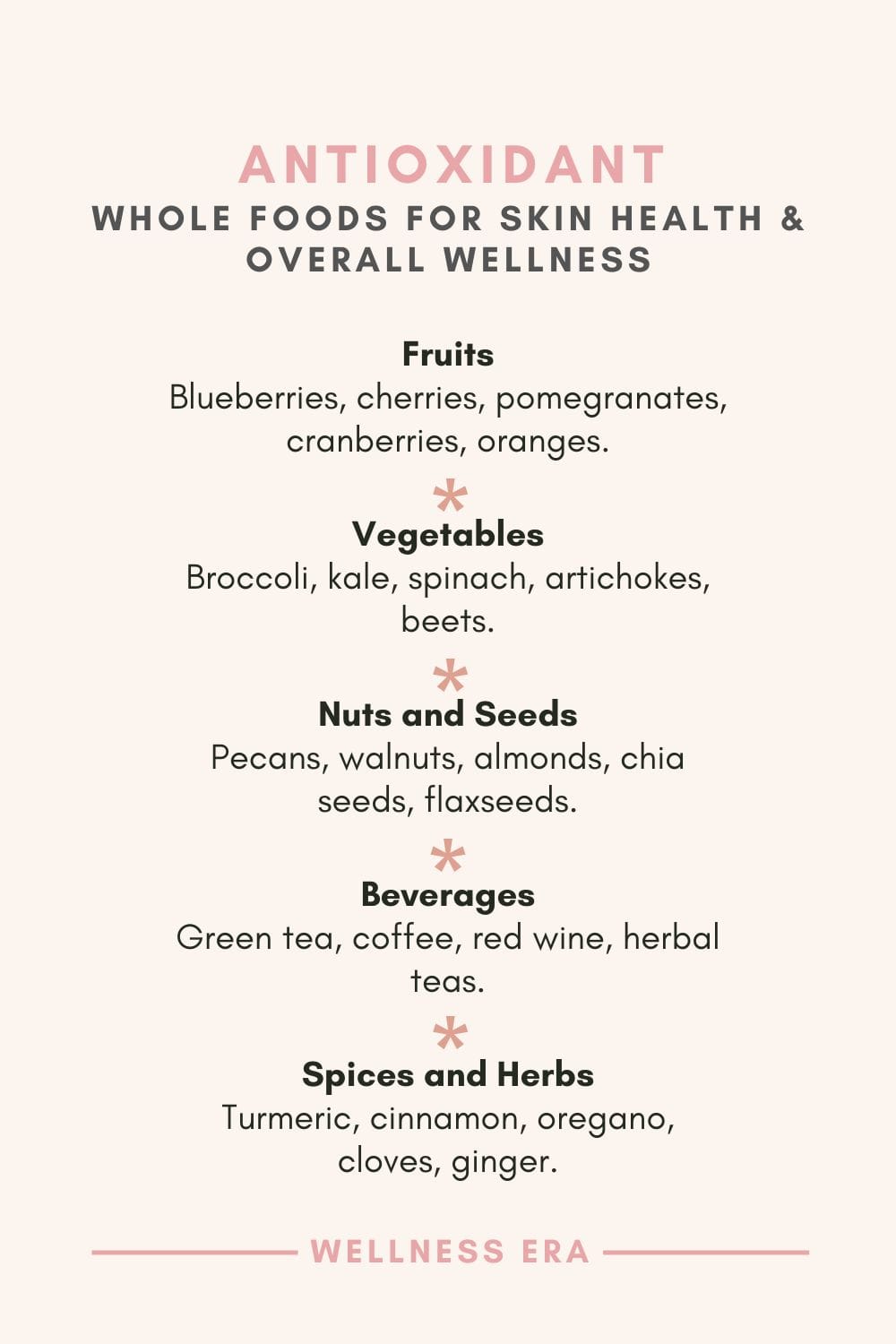
Key Antioxidant Nutrients
Vitamin C
Vitamin C, is a water-soluble antioxidant found in high concentrations in citrus fruits (oranges, lemons), strawberries, bell peppers, and kiwis. It scavenges free radicals in aqueous environments and plays a vital role in regenerating other antioxidants, such as vitamin E (Halliwell, 2012).
Vitamin E
This fat-soluble antioxidant, protects cell membranes from lipid peroxidation. Rich sources include nuts (almonds, hazelnuts), seeds (sunflower seeds), spinach, and avocados (Traber and Atkinson, 2007).
Polyphenols
Polyphenols are a diverse group of antioxidants abundant in dark chocolate, green tea, coffee, grapes, and apples. These compounds, exhibit strong free radical-scavenging properties and offer protection against chronic diseases (Scalbert et al., 2005).
Carotenoids
Carotenoids are plant pigments with antioxidant activity, found in carrots, sweet potatoes, kale, spinach, and tomatoes. Prominent examples include beta-carotene, lutein, and lycopene, which protect against oxidative damage in lipid-rich tissues (Krinsky and Johnson, 2005).
Polyphenols
Polyphenols are a diverse group of antioxidants abundant in dark chocolate, green tea, coffee, grapes, and apples. These compounds, exhibit strong free radical-scavenging properties and offer protection against chronic diseases (Scalbert et al., 2005).
Flavonoids
A subgroup of polyphenols, flavonoids are highly concentrated in berries (blueberries, raspberries), citrus fruits, onions, and tea. They exhibit anti-inflammatory and antioxidant activities by modulating enzymatic pathways and scavenging reactive oxygen species (Manach et al., 2004).
Selenium
Selenium is a trace element integral to the antioxidant enzyme glutathione peroxidase. It is found in Brazil nuts, seafood, eggs, and sunflower seeds and plays a crucial role in protecting cells from oxidative stress (Rayman, 2000).
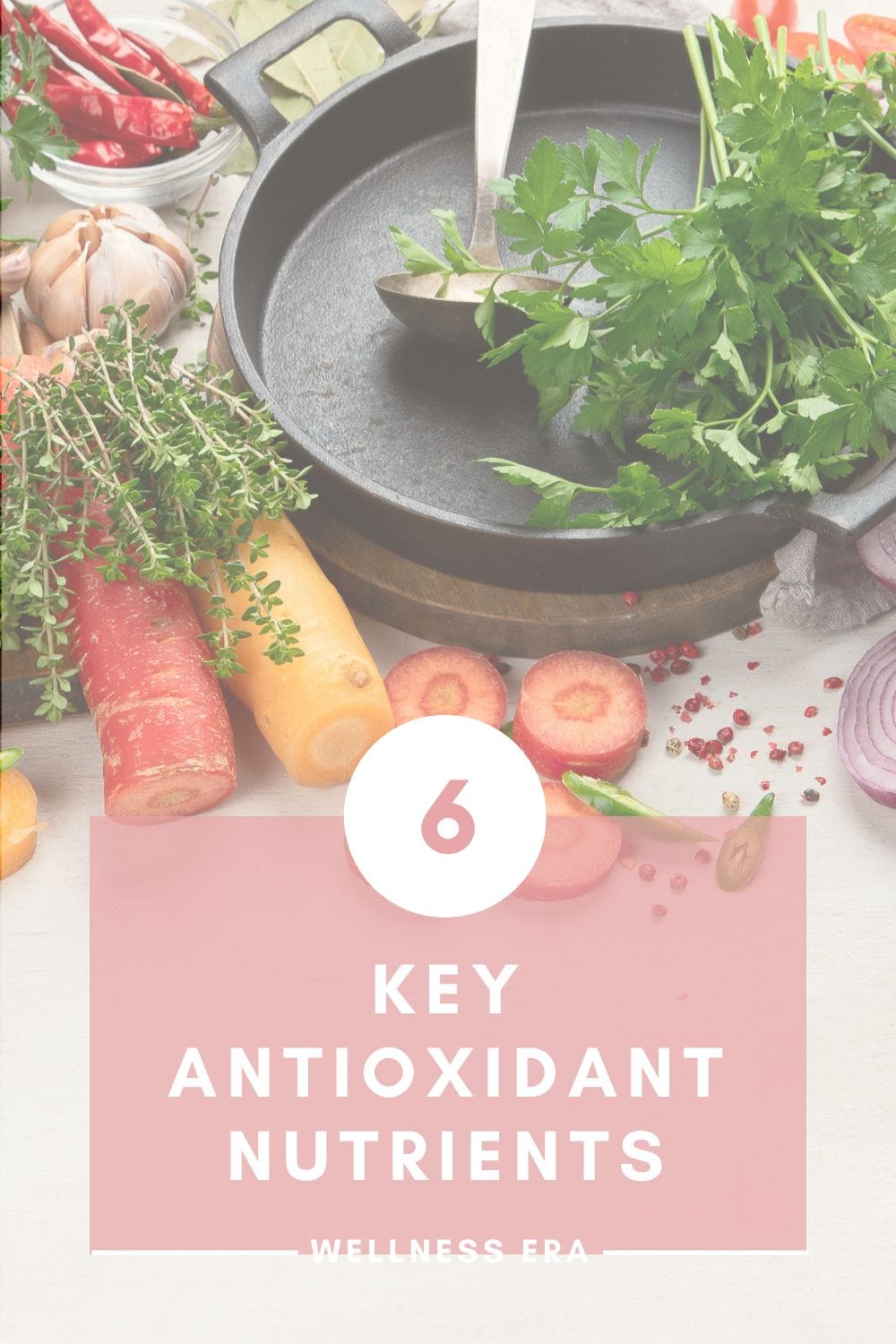
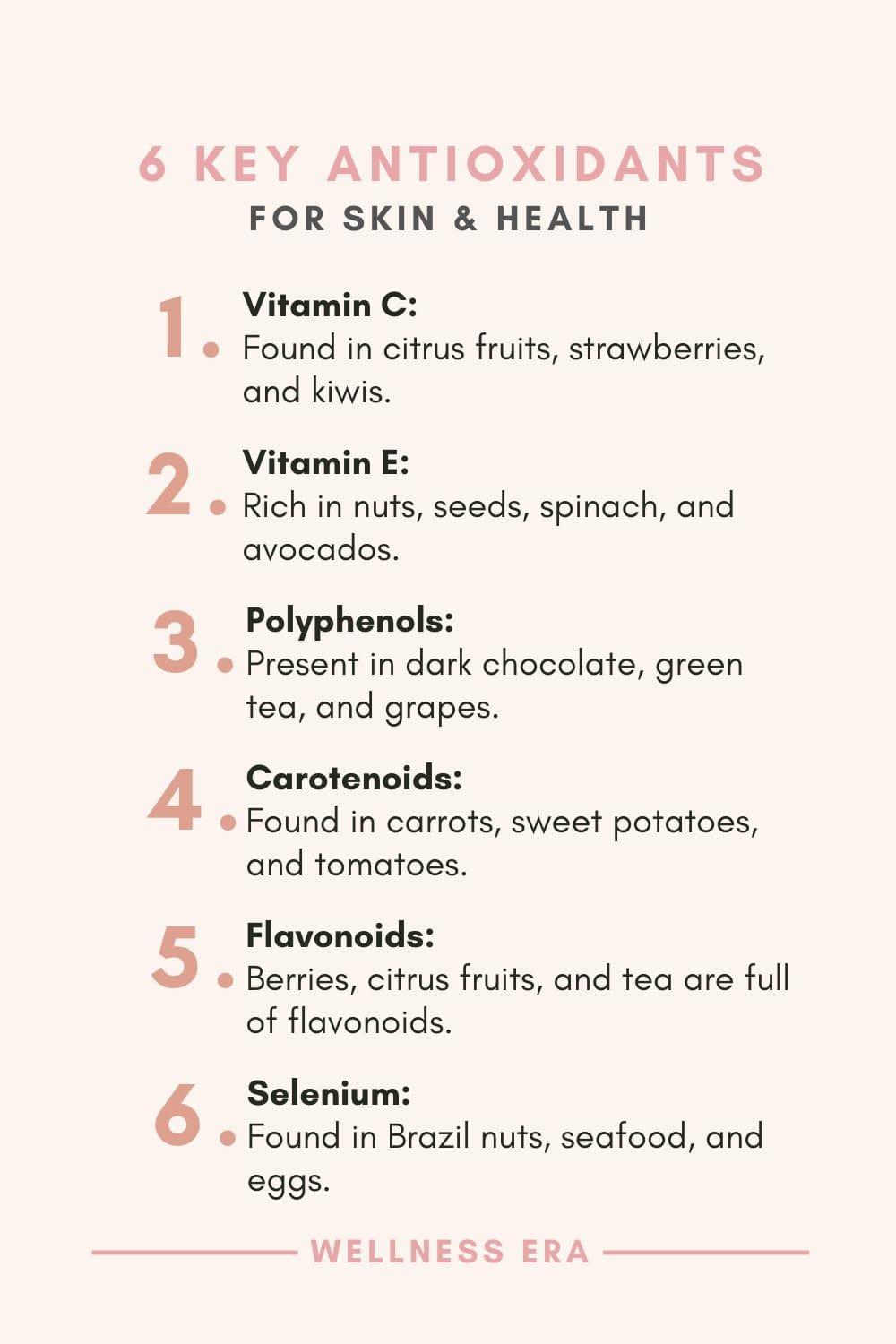
Incorporate Antioxidants As Topical Skincare:
Topical antioxidants are skin care ingredients that combat oxidative stress caused by free radicals. Applying these directly to the skin will help neutralize free radicals on the surface and prevent further damage. (Sies, 2017).
Topical antioxidants help in neutralizing free radicals, reducing inflammation, improving skin tone, preventing photoaging, and boosting the efficacy of sunscreens. They also enhance the skin's natural repair processes and improve hydration, making them essential in daily skincare regimens (Sies and Berndt, 2017).
To maximize your skincare routine, pair antioxidant-rich products with deeply nourishing moisturizers. Discover the best natural moisturizers for aging skin that support hydration and long-lasting radiance.
Topical Antioxidant Heroes
Green Tea Extract Serums are rich in polyphenols, which is known for its potent antioxidant and anti-inflammatory properties. These serums help reduce redness, combat inflammation, and protect against UV-induced damage. (Katiyar, 2003).
Vitamin C Serums are an excellent choice for brightening skin, reducing hyperpigmentation, and stimulating collagen production. Vitamin C, also known as ascorbic acid, is a water-soluble antioxidant that neutralizes free radicals. (Pinnell et al., 2001).
Rosehip Oil is packed with vitamin A (retinoids) and vitamin C, making it a powerful natural option for promoting cell regeneration and improving skin tone. It also provides deep hydration. (Sorg et al., 2006).
Aloe Vera Gel is a gentle and versatile product containing natural antioxidants like vitamins C and E, as well as polyphenols. It hydrates the skin, soothes irritation, and helps reduce oxidative stress. (Rayman, 2000).
Pomegranate Seed Oil is rich in punicalagins, vitamin E, and polyphenols, offering protection against sun damage, reducing wrinkles, and boosting skin elasticity. (Shukla et al., 2008).
These natural products have antioxidant effects by applying them directly onto the skin. They can also be are categorized into different types based on their chemical structure and function. Which you can discover below:
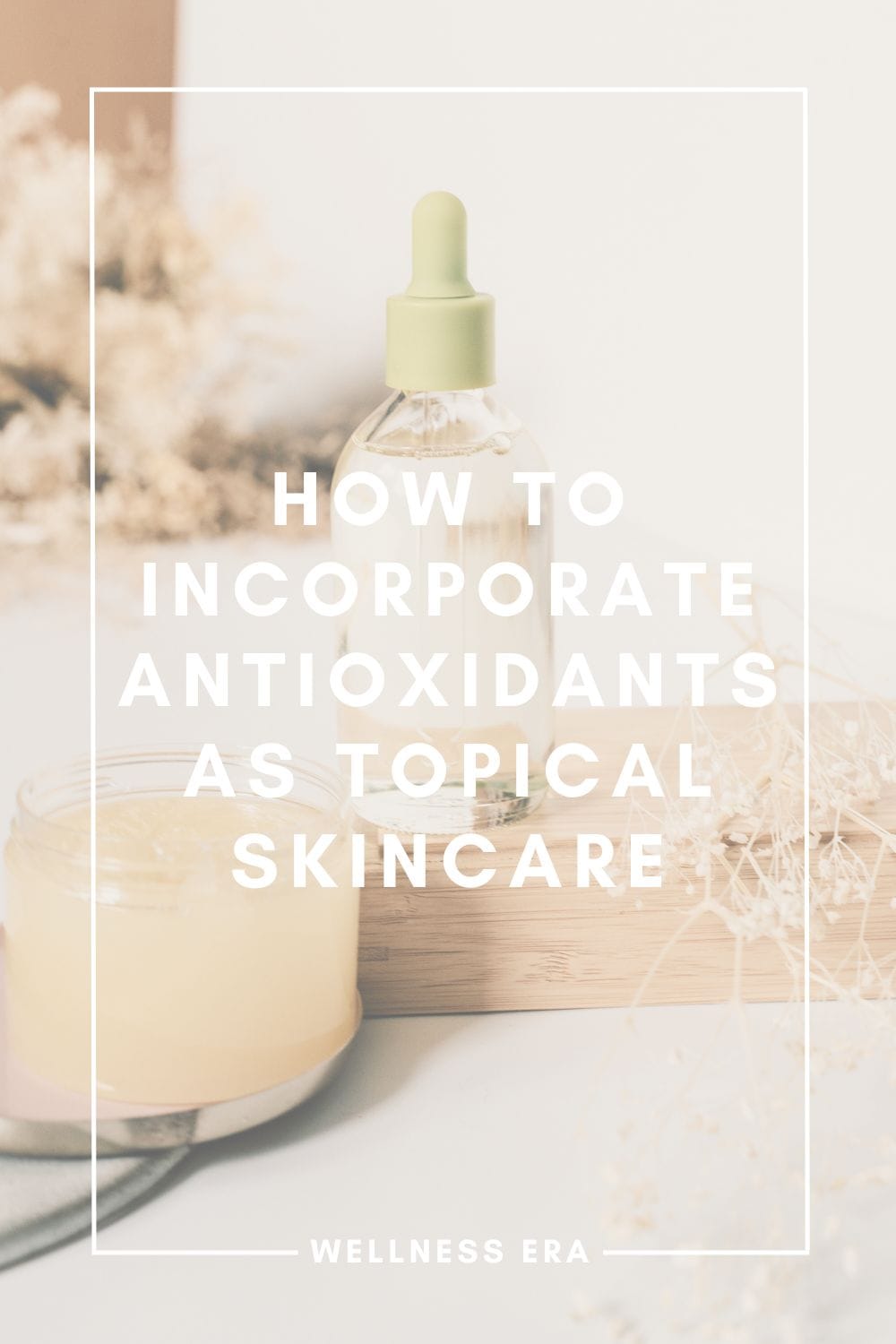
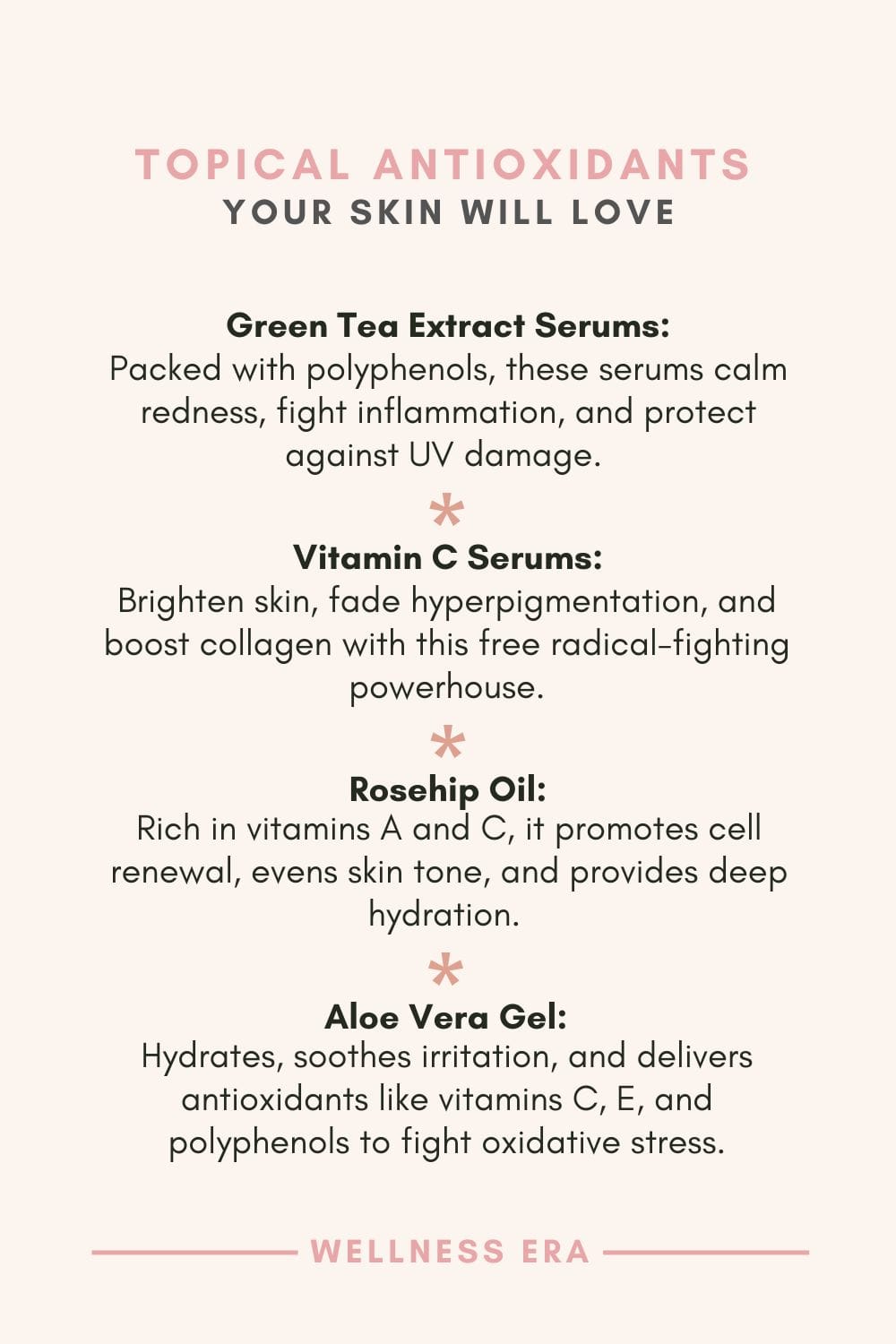
Vitamin C (Ascorbic Acid)
Vitamin C is a powerful antioxidant that neutralizes free radicals and promotes collagen synthesis. It brightens the skin, reduces hyperpigmentation, and protects against photoaging when applied topically (Pinnell et al., 2001).
Vitamin E (Tocopherol)
A fat-soluble antioxidant, vitamin E protects the skin's lipid barrier from oxidative damage. It is often combined with vitamin C to enhance its photoprotective effects and improve skin hydration (Shen et al., 2012).
Niacinamide (Vitamin B3)
Niacinamide improves skin barrier function, reduces inflammation, and scavenges reactive oxygen species. It also minimizes fine lines, wrinkles, and hyperpigmentation (Draelos, 2013).
Polyphenols
Found in green tea, resveratrol, and grape seed extract, polyphenols reduce inflammation and oxidative stress. Green tea polyphenols, particularly epigallocatechin gallate (EGCG), have anti-aging and photoprotective properties (Katiyar, 2003).
Coenzyme Q10 (Ubiquinone)
Coenzyme Q10 is a naturally occurring antioxidant that decreases with age. It reduces oxidative stress, enhances skin repair, and minimizes signs of aging (Hoppe et al., 1999).
Retinoids (Vitamin A Derivatives)
Retinoids like retinol not only promote cell turnover but also exhibit antioxidant properties. They reduce fine lines, improve texture, and enhance collagen production (Sorg et al., 2006).
Selenium
Selenium-based topical formulations protect skin from UV-induced damage and maintain cellular health by supporting antioxidant enzymes like glutathione peroxidase (Rayman, 2000).
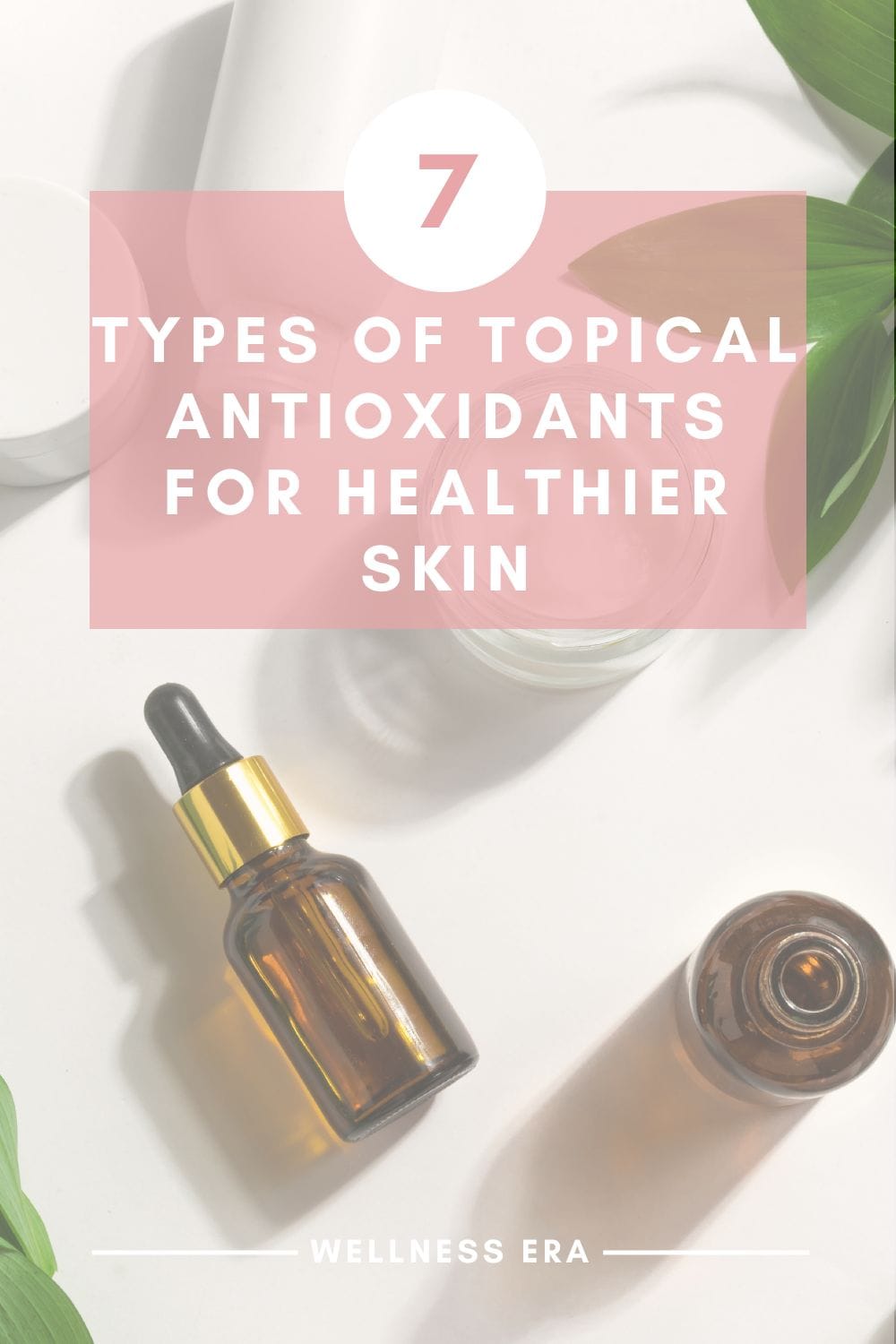
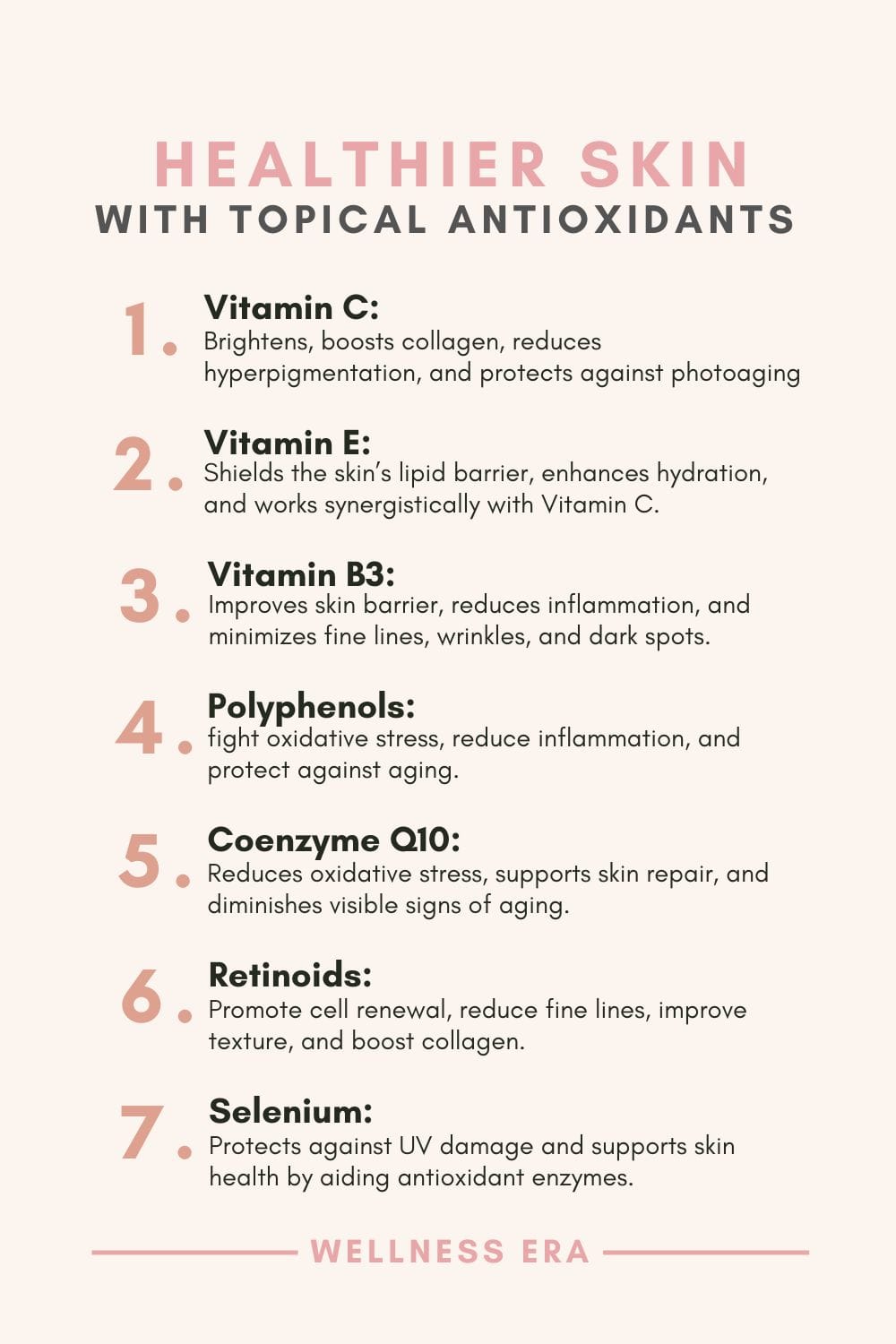
References
Draelos, Z.D. (2013). Nutritional antioxidants in anti-aging therapy. Dermatologic Therapy, 26(5), 313–317. Wiley Online Library
Halliwell, B. (2012). Free radicals and antioxidants – quo vadis? Trends in Pharmacological Sciences, 33(3), 77–90. ScienceDirect
Hoppe, U. et al. (1999). Coenzyme Q10, a cutaneous antioxidant and energizer. Biofactors, 9(2–4), 371–378. PubMed
Katiyar, S.K. (2003). Skin photoprotection by green tea: antioxidant and immunomodulatory effects. Current Drug Targets-Immune, Endocrine & Metabolic Disorders, 3(3), 234–242. PubMed
Krinsky, N.I., & Johnson, E.J. (2005). Carotenoid actions and their relation to health and disease. Molecular Aspects of Medicine, 26(6), 459–516. ScienceDirect
Manach, C., Scalbert, A., Morand, C., Rémésy, C., & Jiménez, L. (2004). Polyphenols: food sources and bioavailability. The American Journal of Clinical Nutrition, 79(5), 727–747. URL
Pinnell, S.R. et al. (2001). Topical L-ascorbic acid: percutaneous absorption studies. Dermatologic Surgery, 27(2), 137–142. PubMed
Rayman, M.P. (2000). The importance of selenium to human health. The Lancet, 356(9225), 233–241. ScienceDirect
Scalbert, A., Johnson, I.T., & Saltmarsh, M. (2005). Polyphenols: antioxidants and beyond. The American Journal of Clinical Nutrition, 81(1), 215S–217S. URL
Shen, J. et al. (2012). Vitamin E: function and metabolism. FASEB Journal, 26(12), 4817–4830. Wiley Online Library
Shukla, Y. et al. (2008). Pomegranate and its components as chemopreventive agents: evidence from laboratory and clinical studies. Current Drug Targets, 9(7), 101-110. PubMed
Sies, H., & Berndt, C. (2017). Oxidative stress: antioxidants in dermatology. Redox Biology, 11, 101–113. ScienceDirect
Sorg, O. et al. (2006). Retinoids and carotenoids in dermatology: a biochemist's view. Dermatology, 213(2), 99–108. URL
Traber, M.G., & Atkinson, J. (2007). Vitamin E, antioxidant and nothing more. Free Radical Biology and Medicine, 43(1), 4–15. ScienceDirect
Fighting Free Radicals
Free radicals are unavoidable, but their damaging effects don’t have to be. By incorporating antioxidants into your diet and skincare routine, you can safeguard your skin against premature aging and maintain a radiant complexion.
Frequent Asked Questions (FAQs)
What are free radicals, and why do they damage skin?
Free radicals are unstable molecules that damage skin proteins and DNA, causing aging and dullness.
How do antioxidants neutralize free radicals?
Antioxidants donate electrons to stabilize free radicals, preventing cellular damage.
What foods are rich in antioxidants?
Foods like blueberries, kale, green tea, and nuts are excellent sources of skin-friendly antioxidants.
Can I use antioxidants topically?
Yes! Products like vitamin C serums and green tea extracts effectively fight free radicals on the skin’s surface.
How often should I apply antioxidant skincare products?
Daily use, especially in the morning, is recommended to combat environmental stressors.
Are natural antioxidants better than synthetic ones?
Both are effective, but natural sources often come with added nutrients and fewer side effects.
Here is something you might also like..
Would you like to receive something special?
Try out the best, inspirational weekly newsletter for your natural wellness era!
My Wellness Era Weekly
SUBSCRIBE TO OUR NEWSLETTER
Your Weekly Dose of Natural Wellness
Fill out the form below, and you will reveice "My Wellness Era Weekly" delivered to your inbox.
What you can expect: a short, warm, and personal note from our founder. Mindset shifts, journal prompts, or self-care reminders. Inspiring quotea related to wellness, mindfulness, or self-love. Small, actionable wellness habits you can try. Recomendations we love, are testing, or recently discovered. Highlights of our latest blog posts.
+++ What we’re loving every single week.
QUICK LINKS
SOCIAL
CATEGORIES



